key battery TOYOTA YARIS 2012 Owner's Manual
[x] Cancel search | Manufacturer: TOYOTA, Model Year: 2012, Model line: YARIS, Model: TOYOTA YARIS 2012Pages: 704, PDF Size: 27.58 MB
Page 445 of 704
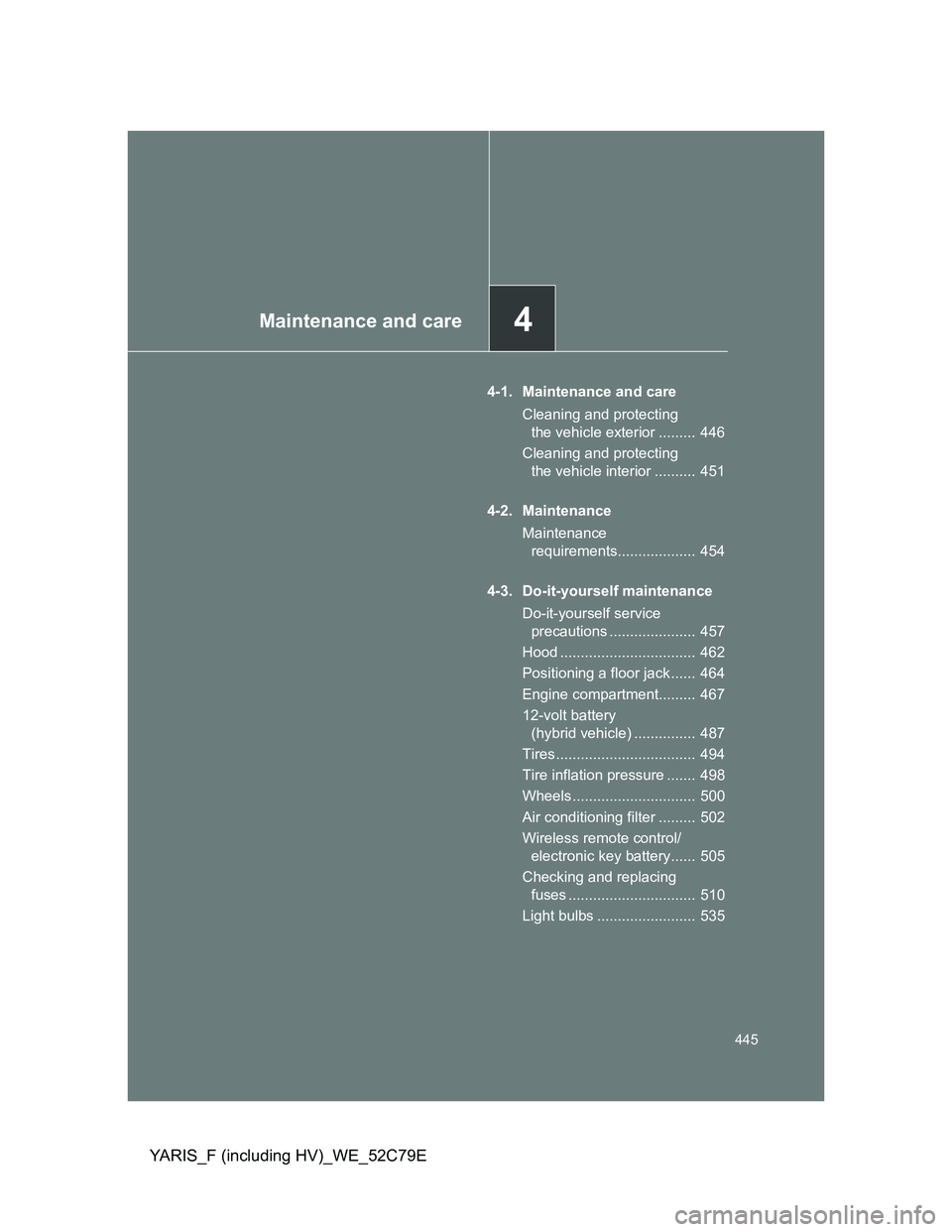
4Maintenance and care
445
YARIS_F (including HV)_WE_52C79E
4-1. Maintenance and care
Cleaning and protecting
the vehicle exterior ......... 446
Cleaning and protecting
the vehicle interior .......... 451
4-2. Maintenance
Maintenance
requirements................... 454
4-3. Do-it-yourself maintenance
Do-it-yourself service
precautions ..................... 457
Hood ................................. 462
Positioning a floor jack ...... 464
Engine compartment......... 467
12-volt battery
(hybrid vehicle) ............... 487
Tires .................................. 494
Tire inflation pressure ....... 498
Wheels .............................. 500
Air conditioning filter ......... 502
Wireless remote control/
electronic key battery...... 505
Checking and replacing
fuses ............................... 510
Light bulbs ........................ 535
Page 459 of 704

459 4-3. Do-it-yourself maintenance
4
Maintenance and care
YARIS_F (including HV)_WE_52C79E
CAUTION
The engine compartment contains many mechanisms and fluids that may
move suddenly, become hot, or become electrically energized. To avoid death
or serious injury, observe the following precautions:
When working on the engine compartment:
On hybrid vehicles, make sure that the engine switch is in the “LOCK”
position (vehicles without an electronic key) or the “POWER” switch off
(vehicles with an electronic key) and the “READY” indicator are both off.
Keep hands, clothing and tools away from the moving fan and engine
drive belt.
Be careful not to touch the engine, power control unit (hybrid vehicle), radi-
ator, exhaust manifold, etc. right after driving as they may be hot. Oil and
other fluids may also be hot.
Do not leave anything that may burn easily, such as paper and rags, in the
engine compartment.
Do not smoke, cause sparks or expose an open flame to fuel or the bat-
tery. Fuel and battery fumes are flammable.
Be extremely cautious when working on the battery. It contains poisonous
and corrosive sulfuric acid.
Take care because brake fluid can harm your hands or eyes and damage
painted surfaces. If fluid gets on your hands or in your eyes, flush the
affected area with clean water immediately.
If you still experience discomfort, consult a doctor.
Page 483 of 704
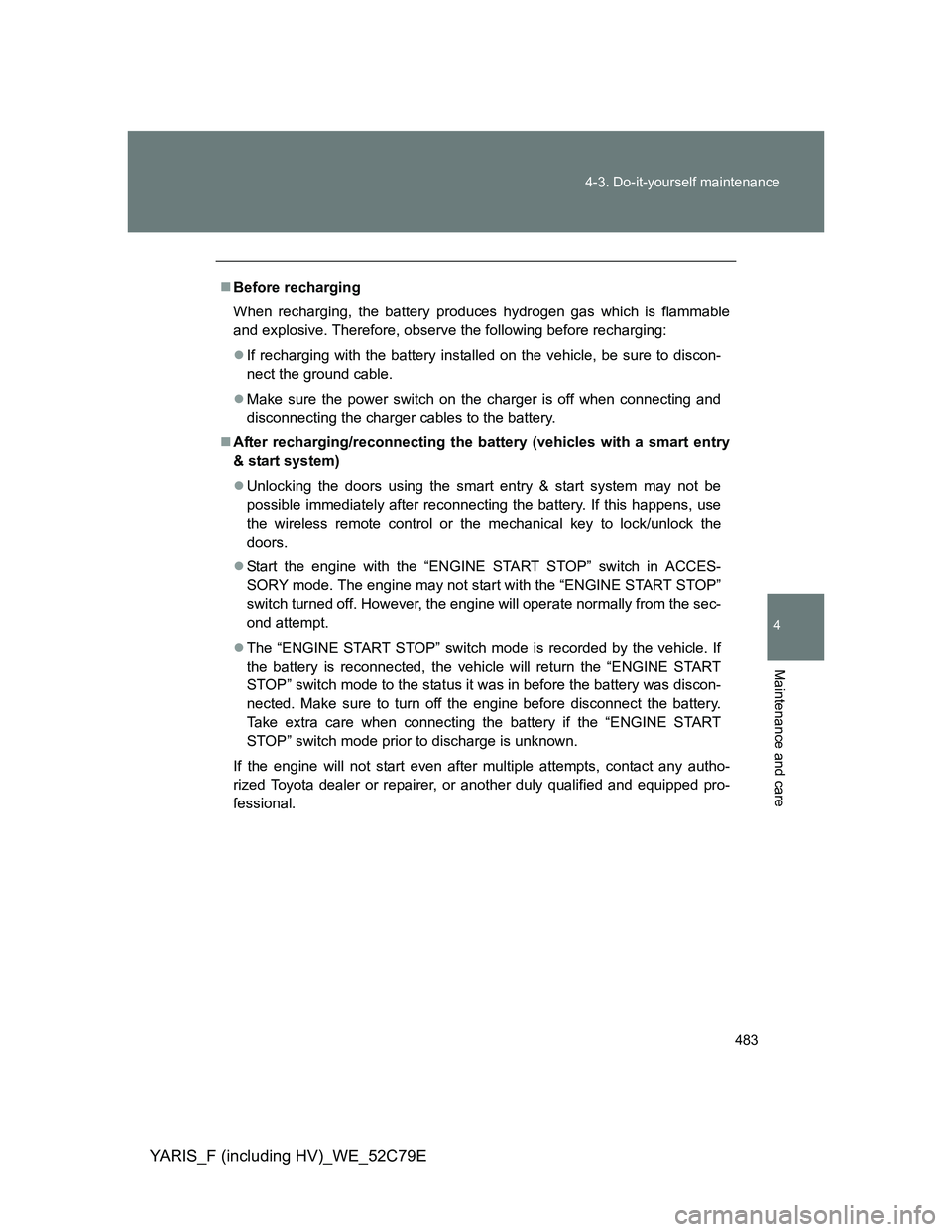
483 4-3. Do-it-yourself maintenance
4
Maintenance and care
YARIS_F (including HV)_WE_52C79E
Before recharging
When recharging, the battery produces hydrogen gas which is flammable
and explosive. Therefore, observe the following before recharging:
If recharging with the battery installed on the vehicle, be sure to discon-
nect the ground cable.
Make sure the power switch on the charger is off when connecting and
disconnecting the charger cables to the battery.
After recharging/reconnecting the battery (vehicles with a smart entry
& start system)
Unlocking the doors using the smart entry & start system may not be
possible immediately after reconnecting the battery. If this happens, use
the wireless remote control or the mechanical key to lock/unlock the
doors.
Start the engine with the “ENGINE START STOP” switch in ACCES-
SORY mode. The engine may not start with the “ENGINE START STOP”
switch turned off. However, the engine will operate normally from the sec-
ond attempt.
The “ENGINE START STOP” switch mode is recorded by the vehicle. If
the battery is reconnected, the vehicle will return the “ENGINE START
STOP” switch mode to the status it was in before the battery was discon-
nected. Make sure to turn off the engine before disconnect the battery.
Take extra care when connecting the battery if the “ENGINE START
STOP” switch mode prior to discharge is unknown.
If the engine will not start even after multiple attempts, contact any autho-
rized Toyota dealer or repairer, or another duly qualified and equipped pro-
fessional.
Page 491 of 704

491 4-3. Do-it-yourself maintenance
4
Maintenance and care
YARIS_F (including HV)_WE_52C79E
Before recharging
When recharging, the 12-volt battery produces hydrogen gas which is flam-
mable and explosive. Therefore, observe the following precautions before
recharging:
If recharging with the 12-volt battery installed on the vehicle, be sure to
disconnect the ground cable.
Make sure the power switch on the charger is off when connecting and
disconnecting the charger cables to the 12-volt battery.
When disconnecting the 12-volt battery terminals
Always disconnect the negative (-) terminal first.
After recharging/reconnecting the 12-volt battery
Unlocking the doors using the smart entry & start system may not be
possible immediately after reconnecting the 12-volt battery. If this hap-
pens, use the wireless remote control or the mechanical key to lock/
unlock the doors.
Vehicles with an electronic key: Start the hybrid system with the
“POWER” switch in ACCESSORY mode. The hybrid system may not
start with the “POWER” switch turned off. However, the hybrid system will
operate normally from the second attempt.
Caution symbols
The meanings of each caution symbol on the top of the battery are
as follows:
No smoking, no naked
flames, no sparksBattery acid
Shield eyesNote operating
instructions
Keep away from childrenExplosive gas
Page 492 of 704

492 4-3. Do-it-yourself maintenance
YARIS_F (including HV)_WE_52C79E
Vehicles with an electronic key: The “POWER” switch mode is recorded
by the vehicle. If the 12-volt battery is reconnected, the vehicle will return
the “POWER” switch mode to the status it was in before the 12-volt bat-
tery was disconnected. Make sure to turn off the power before discon-
nect the 12-volt battery. Take extra care when connecting the 12-volt
battery if the “POWER” switch mode prior to discharge is unknown.
If the system will not start even after multiple attempts, contact any autho-
rized Toyota dealer or repairer, or another duly qualified and equipped pro-
fessional.
CAUTION
Chemicals in the 12-volt battery
The 12-volt battery contains poisonous and corrosive sulfuric acid and may
produce hydrogen gas which is flammable and explosive. To reduce the risk
of death or serious injury, take the following precautions while working on or
near the 12-volt battery:
Do not cause sparks by touching the 12-volt battery terminals with tools.
Do not smoke or light a match near the 12-volt battery.
Avoid contact with eyes, skin and clothes.
Never inhale or swallow electrolyte.
Wear protective safety glasses when working near the 12-volt battery.
Keep children away from 12-volt battery.
Where to safely charge the 12-volt battery
Always charge the 12-volt battery in an open area. Do not charge the 12-volt
battery in a garage or closed room where there is insufficient ventilation.
When disconnecting the 12-volt battery terminals
Always disconnect the negative (-) terminal first. If the positive (+) terminal is
disconnected first and touches a surrounding metal surface sparks will be
produced, possibly starting a fire. It could also result in an electric shock or
serious injury.
How to recharge the 12-volt battery
Only perform a slow charge (3.5 A or less). The 12-volt battery may explode
if charged at a quicker rate.
Page 505 of 704
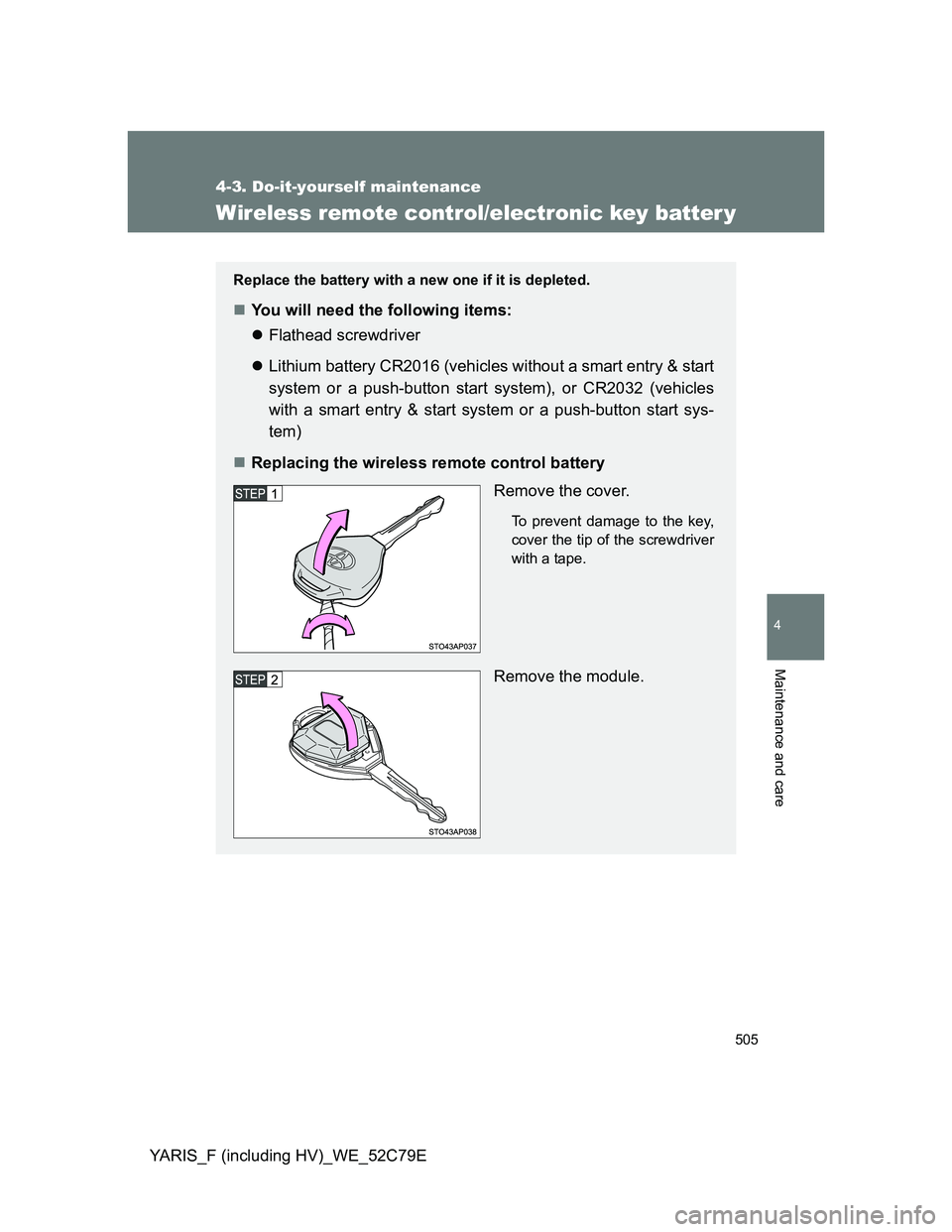
505
4-3. Do-it-yourself maintenance
4
Maintenance and care
YARIS_F (including HV)_WE_52C79E
Wireless remote control/electronic key batter y
Replace the battery with a new one if it is depleted.
You will need the following items:
Flathead screwdriver
Lithium battery CR2016 (vehicles without a smart entry & start
system or a push-button start system), or CR2032 (vehicles
with a smart entry & start system or a push-button start sys-
tem)
Replacing the wireless remote control battery
Remove the cover.
To prevent damage to the key,
cover the tip of the screwdriver
with a tape.
Remove the module.
Page 506 of 704

506 4-3. Do-it-yourself maintenance
YARIS_F (including HV)_WE_52C79E
Remove the battery cover and
the depleted battery.
Insert a new battery with the
“+” terminal facing up.
Replacing the electronic key battery
Ty p e A
Take out the mechanical key.
Remove the cover.
To prevent damage to the key,
cover the tip of the screwdriver
with a tape.
Page 507 of 704
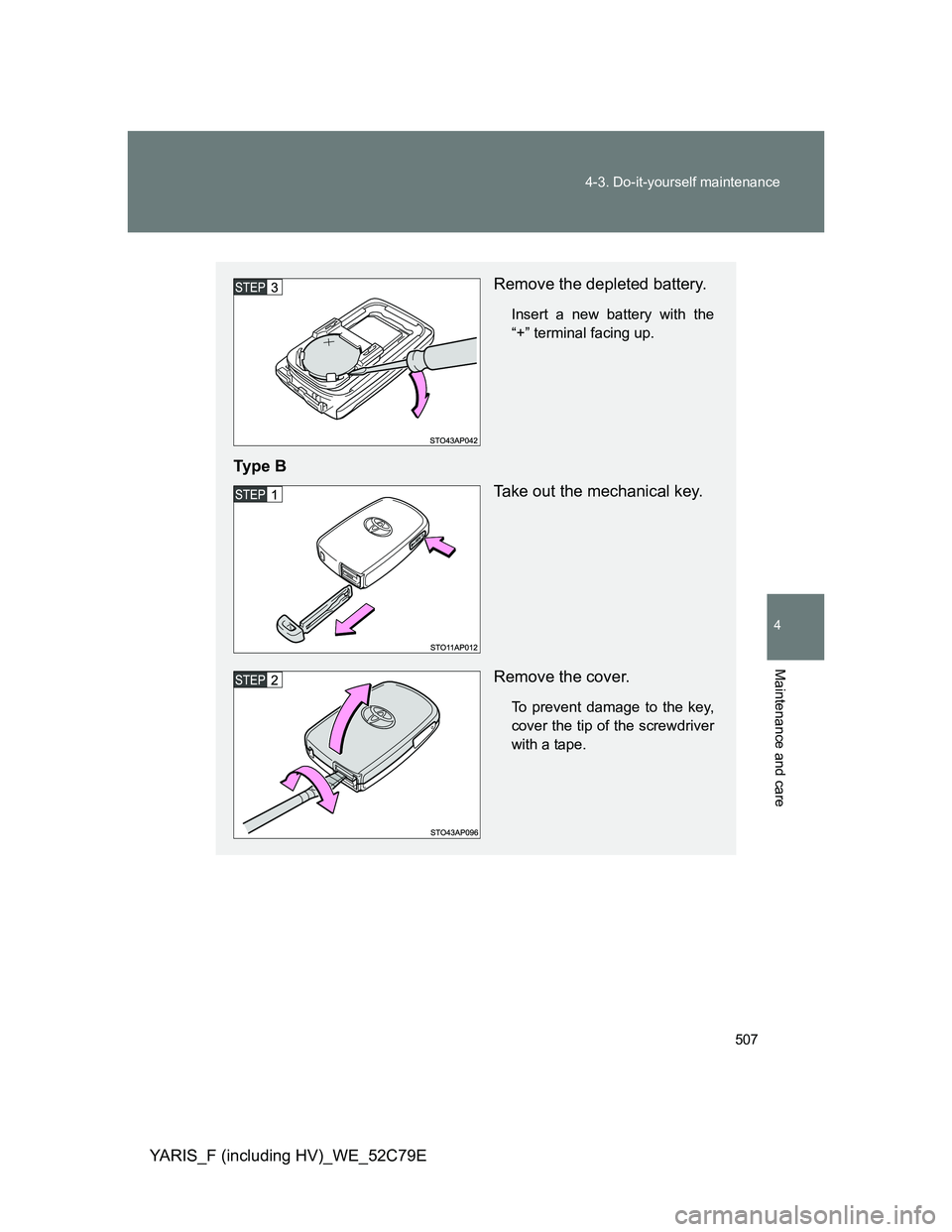
507 4-3. Do-it-yourself maintenance
4
Maintenance and care
YARIS_F (including HV)_WE_52C79E
Remove the depleted battery.
Insert a new battery with the
“+” terminal facing up.
Ty p e B
Take out the mechanical key.
Remove the cover.
To prevent damage to the key,
cover the tip of the screwdriver
with a tape.
Page 508 of 704
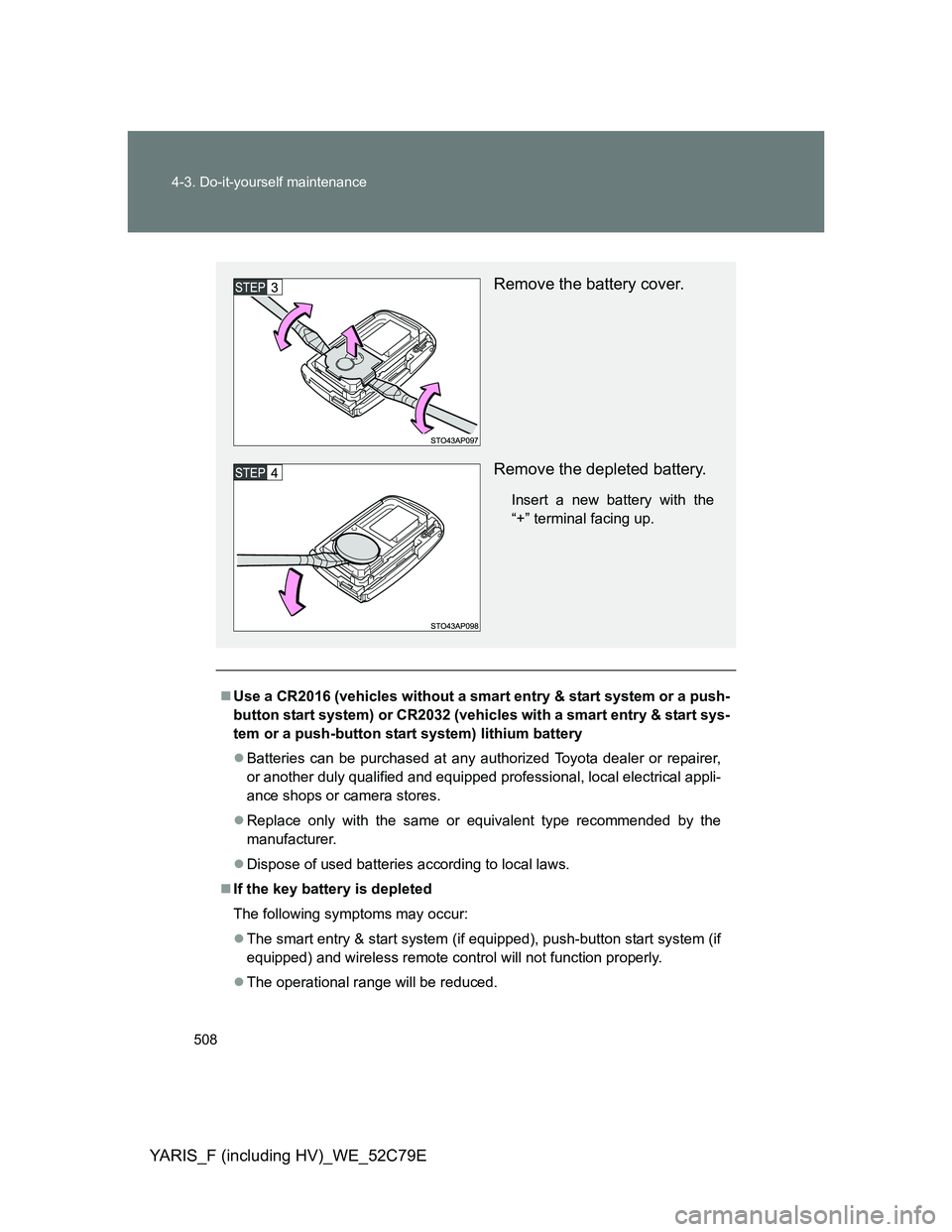
508 4-3. Do-it-yourself maintenance
YARIS_F (including HV)_WE_52C79E
Use a CR2016 (vehicles without a smart entry & start system or a push-
button start system) or CR2032 (vehicles with a smart entry & start sys-
tem or a push-button start system) lithium battery
Batteries can be purchased at any authorized Toyota dealer or repairer,
or another duly qualified and equipped professional, local electrical appli-
ance shops or camera stores.
Replace only with the same or equivalent type recommended by the
manufacturer.
Dispose of used batteries according to local laws.
If the key battery is depleted
The following symptoms may occur:
The smart entry & start system (if equipped), push-button start system (if
equipped) and wireless remote control will not function properly.
The operational range will be reduced.
Remove the battery cover.
Remove the depleted battery.
Insert a new battery with the
“+” terminal facing up.
Page 551 of 704
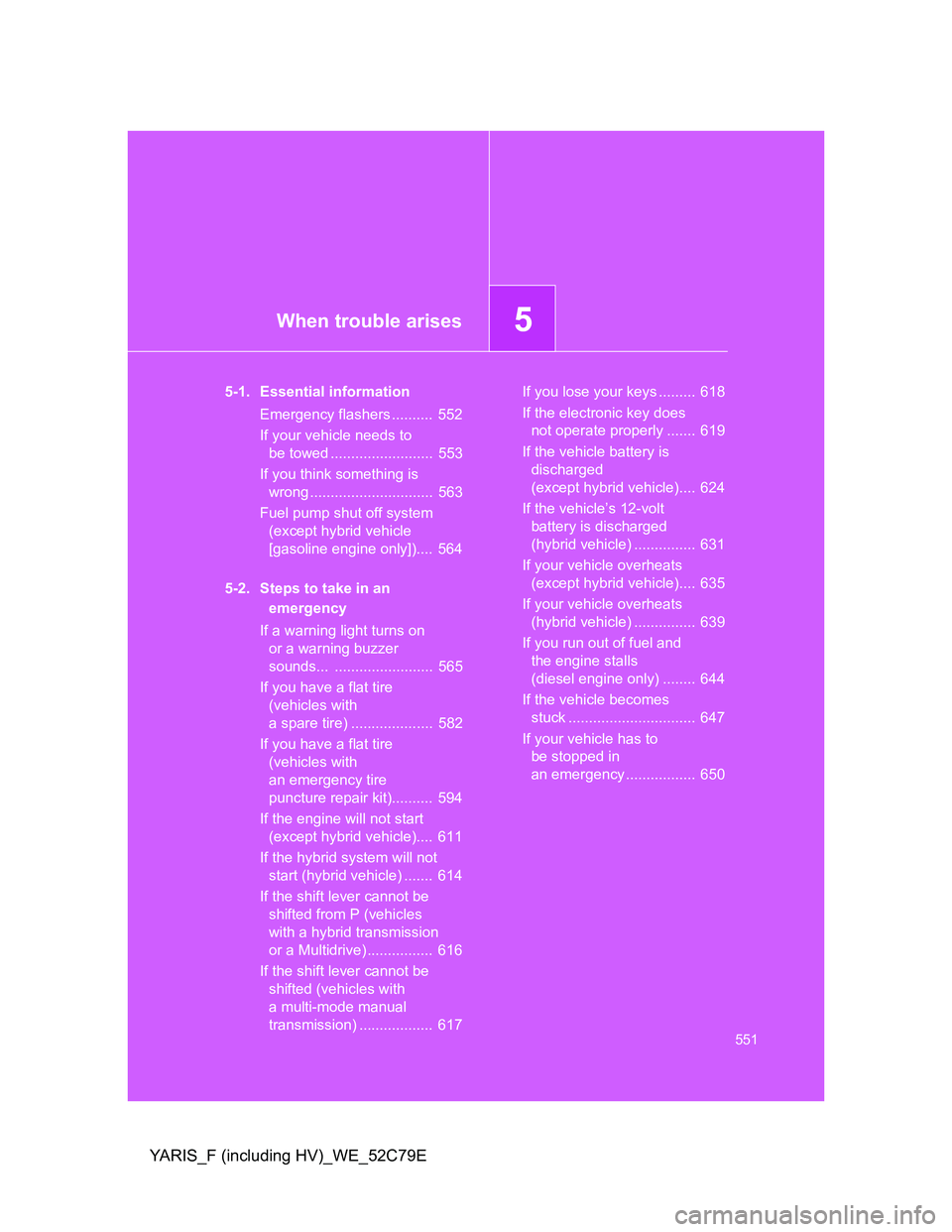
5When trouble arises
551
YARIS_F (including HV)_WE_52C79E
5-1. Essential information
Emergency flashers .......... 552
If your vehicle needs to
be towed ......................... 553
If you think something is
wrong .............................. 563
Fuel pump shut off system
(except hybrid vehicle
[gasoline engine only]).... 564
5-2. Steps to take in an
emergency
If a warning light turns on
or a warning buzzer
sounds... ........................ 565
If you have a flat tire
(vehicles with
a spare tire) .................... 582
If you have a flat tire
(vehicles with
an emergency tire
puncture repair kit).......... 594
If the engine will not start
(except hybrid vehicle).... 611
If the hybrid system will not
start (hybrid vehicle) ....... 614
If the shift lever cannot be
shifted from P (vehicles
with a hybrid transmission
or a Multidrive) ................ 616
If the shift lever cannot be
shifted (vehicles with
a multi-mode manual
transmission) .................. 617If you lose your keys ......... 618
If the electronic key does
not operate properly ....... 619
If the vehicle battery is
discharged
(except hybrid vehicle).... 624
If the vehicle’s 12-volt
battery is discharged
(hybrid vehicle) ............... 631
If your vehicle overheats
(except hybrid vehicle).... 635
If your vehicle overheats
(hybrid vehicle) ............... 639
If you run out of fuel and
the engine stalls
(diesel engine only) ........ 644
If the vehicle becomes
stuck ............................... 647
If your vehicle has to
be stopped in
an emergency ................. 650